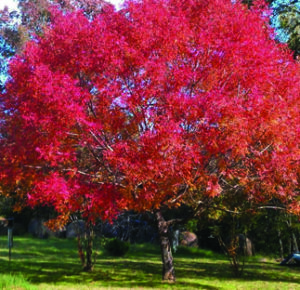By Debbie Roland and
Emmy Ulmschneider
Master Gardeners
Looking for a tree for your yard? Chinese Pistache, Pistacia chinensis, can grow to 40’ tall and 40’ wide and shows brilliant fall color. Small greenish flowers appear in spring above the foliage. This tree is dioecious: male and female flowers appear on separate trees. The small, greenish female flower appears in spring above the foliage and if pollinated lead to clusters of red round fruit which ripen to a blue in the fall just in time for fall bird migration. To humans the fruits, called drupes, are inedible. The immature fruits will drop off in high winds in the summer and then the ripe fruits drop off in the fall and winter. Female trees do not produce large quantities of seeds until fully established in the landscape. Once mature the female tree will produce large quantities so plant this tree where the female’s fruits and seeds won’t be a problem. Most gardeners feel that the beauty of the tree outweighs the inconvenience.

The trunk is light tan to gray and will strip or flake with age, developing a rough texture. Typically used as a landscaping tree, Chinese Pistache will thrive in full sun. It requires no fertilizer and is drought resistant in any type of soil. Due to the mature size of this tree, it may not be suitable for small yards, but perfect for mid-size to large areas.
Pests and disease are not usually a problem although Chinese Pistache can be susceptible to verticullum wilt.
Like many of our ornamental trees, Chinese Pistache is not native to North America. It is native to China, Taiwan, and the Philippines. In the United States, we often find it as a street tree or as a small to medium tree in a residential landscape.
If you prefer a tree that is native to Texas, take a look at the Anacardiaceae, (Sumac) Family. There are two natives.
The Texas Pistachio, Pistacia Mexicana, and the Flameleaf Sumac, Rhus lanceolata. Texas Pistache is evergreen, smaller, but does not have the beautiful fall color.
Flameleaf Sumac has the outstanding orange red fall foliage that gives this plant its name as well as the red drupes which can be used to make a Vitamin C rich tea.
If you are interested in fall color, Bigtooth Maple, Acer grandidentatum, and Texas Ash, Fraxinus texensis, also have spectacular fall color.
For more information, call the AgriLife office at 498-4071 in Odessa or at 686-4700 in Midland or visit aggie-horticulture.tamu.edu or westtexasgardening.org.




